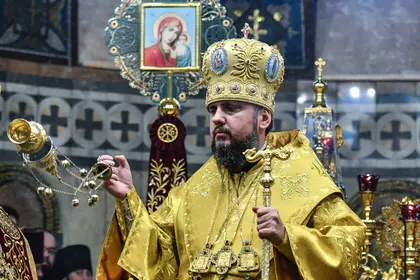Every year, linguists choose words that have attracted the most public interest and encapsulated key events.
In 2018, many in Ukraine learned a Greek word. This piece of Orthodox terminology, once the exclusive jargon of church clerics, entered the daily vocabulary of politicians, journalists, and ordinary people in the run-up to the creation of the unified Ukrainian Orthodox Church — a new, internationally-recognized national orthodox church independent of the Russian Orthodox Church of the Moscow Patriarchate.
The word is “tomos,” and it was one of the most searched words on Google in Ukraine this year. In Greek, it literally means “a section” and is related to the verb “to cut.”
By extension, it came to refer to a section of a papyrus scroll, on which books used to be written, and then to a volume of a book, which is where we also get the English word “tome.”
Keenly awaited
In the narrower meaning in Orthodox church terminology, a tomos is indeed a scroll or a small book, but one with a very specific purpose — it codifies a decision by a holy synod, or council of Orthodox bishops.
The tomos now keenly awaited in Ukraine is hugely important in the religious life of the country, as this document will officially grant autocephaly, or independence, to its Orthodox Church. Ukraine expects to receive the tomos on Jan. 6, on Orthodox Christmas Eve.
It will be issued by the highest body of the Eastern Orthodox world, the Ecumenical Patriarchate of Constantinople, based in Istanbul. President Petro Poroshenko and Metropolitan Epiphanius plan to go to Istanbul to receive it.
Google Trends shows several spikes in searches for the word tomos corresponding to key events. The first spike in April followed Poroshenko’s meeting with the leader of the world’s Orthodox churches, Ecumenical Patriarch Bartholomew, in Istanbul, which started the process of creating an independent church in Ukraine and launched the process of receiving a tomos of autocephaly.
The next spike occurred in October, when after a months-long council, the Ecumenical Patriarchate of Constantinople decided to grant Ukraine permission to create its own unified Orthodox church, separate from the Russian Orthodox Church.
National church
Instead of three Orthodox churches in Ukraine, of which only the one subordinate to the Moscow Patriarchate was a recognized canonic body, Ukrainians will now have one national church headed by Metropolitan Epiphanius, who was elected its head at the unification council in Kyiv on Dec. 15.
Many believed the person who should lead the national Ukrainian Orthodox Church was Metropolitan of Kyiv Filaret, who spearheaded the fight for the independence of Ukrainian Orthodox Church from the Moscow Patriarchate that started when Ukraine became a sovereign state in 1991. Filaret was excommunicated for over two decades until Constantinople in October rescinded the Moscow church’s decision to anathemize him.
Thousands of Ukrainians gathered on the square in front of St. Sophia’s Cathedral on Dec. 15, despite sub-zero temperatures outside to watch a live broadcast of the unification council. Even those who are not religious celebrated the news of the creation of the new Ukrainian Orthodox Church and the granting of tomos — an event of political as well as religious significance.
That is because it is another stage in Ukraine’s divorce from Russia, which has dominated Ukraine politically and religiously for centuries.
Political show
The church independence was also a political show for Poroshenko.
The president has made religious affairs his own as he appears to aim for re-election next year. The church is one of the three pillars of his pre-election campaign, tag-lined “Army. Language. Faith.”
He has shown a great deal of fervor and determination in winning Ukraine “spiritual independence from Russia” — much more than in fighting corruption or investigating the murders of journalists and activists, which, if done, would lift the nation’s spirits no less.
Poroshenko has expended so much effort on this project that only eight months passed from the moment the president met with the Ecumenical Patriarch in Istanbul until the moment he stood on a stage next to the newly elected Metropolitan of Kyiv and All Ukraine Epiphanius.
Poroshenko called the local Ukrainian Orthodox Church a church “without (Vladimir) Putin and (Russian Orthodox Patriarch) Kirill.”
Indeed, Patriarch Kirill is viewed as extremely close to Russian President Putin and has expressed political support for the Kremlin dictator, even describing his rule as “a miracle.”
But Poroshenko’s active role in helping to create a unified Ukrainian Orthodox Church and obtaining a tomos for it ahead of next year’s presidential election is, in a sense, a similar marriage between state and church, which are otherwise separated under the Constitution.
You can also highlight the text and press Ctrl + Enter




